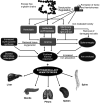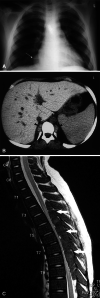Paraspinal extramedullary hematopoiesis in patients with thalassemia intermedia
- PMID: 20204423
- PMCID: PMC2899982
- DOI: 10.1007/s00586-010-1357-2
Paraspinal extramedullary hematopoiesis in patients with thalassemia intermedia
Abstract
Ineffective erythropoiesis in patients with thalassemia intermedia drives extramedullary hematopoietic tumor formation in several parts of the body. Paraspinal involvement has received increasing attention due to the associated morbidity secondary to spinal cord compression. Although the history and physical examination may help narrow the differential diagnosis, radiographic imaging remains essential to confirm the existence of hematopoietic tissue. Characteristic appearance has been observed mainly on magnetic resonance imaging. Several treatment options have been described, including transfusion therapy, laminectomy, radiotherapy, and the use of fetal hemoglobin inducing agents that decrease the hematopoietic drive. However, the ideal management scheme remains controversial. Until large prospective trials evaluate the efficacy and safety of the available treatment options, both in single and in combination therapy, an individualized approach should be entertained.
Figures




References
-
- Weatherall DJ, Clegg JB. The thalassemia syndromes. 4. Oxford: Blackwell Scientific Publications; 2001.
-
- Cromwell LD, Kerber C. Spinal cord compression by extramedullary hematopoiesis in myeloid metaplasia. Radiology. 1978;128:118. - PubMed
Publication types
MeSH terms
LinkOut - more resources
Full Text Sources
Other Literature Sources
Medical

